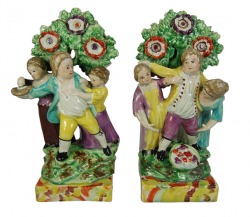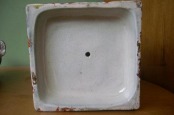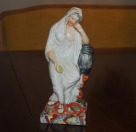



|
When I saw this pair of figures depicting Elijah and the Widow of Zarephath my eye was immediately drawn to the bases. The figures are in the stock of Frost Antiques.  The bases seemed akin to those on the Scuffle and Contest groups I wrote about in my April 6 posting. No bocages to provide an added clue...but I had to wonder. Usually, I look underneath a figure almost immediately because the base tells so much about the figure--and similarly formed bases (especially if the formation is unusual) can help link figures  I asked Frost Antiques for a picture of the base, and Nick Frost kindly sent this. The base is formed in the same manner as the bases of Scuffle and Contest, (rounded internal corners and a release hole in the center) so the figures may well have common origins...but too soon to know for certain yet. I will be watching for more features that may link these figures into a "family".  You may have noticed the Widow with the brightly painted base at the end of the April 22 posting. Wondering if she is part of the same family too?  I tend to think not because the base is formed quite differently. Bases reveal old collection stickers and price labels, and a lot else. For one thing, they provide an undecorated area where you can tell the color of the original pot and see the glaze. Start turning those figures over and you never know what you may learn.
0 Comments
Few people realize how very many mold parts were required to assemble a Staffordshire figure. I sometimes attempt to work it out and get quite confused in the counting, for even a simple little bocage figure could require dozens of molds.. Clay was pressed into each of the molds, released, and then all the little clay parts were joined together to form the figure that went into the kiln for the first firing. Of course, being a figure potter required a significant investment in molds. Staffordshire's potters were not simpletons; they were wily businessmen. We find numerous cases of molds being re-used to create variations of the same figure form. Case in point is this Songsters spill vase--a compound creation if ever there was one. Of course, the dozens of costly molds needed for this figure HAD to be put to good use, and what easier way to do this than to replace the spill holder with a bocage? I have seen a couple of "versions" of the bocage songsters group--some have dogs, some do not--and fewer of the spill holder version. I am amazed each time at how varying the enameling and minor decorative details can transform the figure group. Think that the potters were satisfied with these two versions of the Songsters? Think again! The same molds could be used to create two quite independent figure groups. And here we see them with the maker's mark WALTON behind and titled SONGSTERS. There seems to have been no limit to the potters' ingenuity in reusing those molds.
No prizes for identifying these figure, because the titles say it all. Elijah and The Widow are quite common Staffordshire figure subjects, so if you want to own a pair buy an attractive pair. The "Sherratt" versions of the figures meet the bill. How do we know that these figures are attributable to the manufactory we loosely dub "Sherratt"? Easy. These figures are loaded with attributes of the "Sherratt" style:
Above, we have a "Sherratt" widow again. This time she is on the uncommon rainbow base that this manufactory used. Note those signature floral garlands on the base, a typical "Sherratt" dress pattern, and the same bocage.
So why Elijah & The Widow? The figures depict the Bible story (First Kings 17) telling how Elijah sought a miracle to nourish the poor Widow of Zarephath and her son. The subject was well presented in classical art, and a print may have inspired the Staffordshire figures. Some potters portray Elijah holding sticks, which would be appropriate for the tale. But others prefer to show him with ravens. These birds are connected to an earlier happening in Elijah's life: the BIble tells that ravens fed Elijah while he was in the dessert. Again, Elijah and the Ravens are depicted in classical art and this--or total confusion!-- may have inspired Elijah and his birds. And lastly, a piece of eye candy. A blog reader kindly sent me this picture, just as I was writing this piece. Don't you love the colorful base? Note that the widow is holding wafers. I believe this is correct because I have seen this modification on another figure on a similar base. I have been mulling the issue of restoration this week and have concluded that my comments on restoration are much too harsh. If we had to discard every broken figure, think of the treasures that would be lost forever? Restoration is part of life and I am going to become more accepting. That being said, I will always hate bad restoration or excessive restoration. And I will always pay a premium for a perfect object. When all the original material is present (for example, a head has been glued back onto a figure) I will remind myself that at least IT IS ALL THERE!
Another thing that has bothered me this week has been the presence of two small 20thC bull baiting groups at UK auction houses, both listed as early 19th C. I sent off my usual email: I am writing to you about the bull baiting figure, lot ***. Please will you look at it again? It is not early 19th century but is instead 20th century. Anthony Oliver's Staffordshire Potter: the Tribal Art of England, pages 45 and 48, tells of this figure being produced by the Kent factory as late as 1960 at a reduced size from the original. Oliver spoke to the man responsible for reducing the figure in size from the Sherratt original. He was very proud of his derivative work and kept an example in a cabinet in his living room! A large, color picture of an early 19th century bull baiting, a Sherratt original, is on p137 of my book, People, Passions, Pastimes, and Pleasures: Staffordshire Figures 1810-1835. The figure measures 13.25 inches across. You can see other examples of your figure under the REPROS tab of my website, www.mystaffordshirefigures.com Thanks so much for checking your figure. With best wishes, Myrna Schkolne The auction houses in question were Wilkinson's and Lawrences of Bletchingley. Wilkinson's replied almost within minutes and very promptly fixed their oversight. Thank you! I still wait to see if I ever get a response from Lawrences of Bletchingley. You can see their figure, sans feet and with an estimate of GBP200-300, by clicking here. And one more issue churning in my mind: the amount of reproduction stuff on eBay is mushrooming. I send out emails, but only about half the sellers respond. Shame on the other half! They know they are trying to foist junk on an unsuspecting public. There are honest sellers on eBay, there really are. There are dishonest sellers, and there are also stupid sellers. I am never sure where the divide is between the last two. In recent months I have bought three small figures on eBay at very modest prices. Each time, my interest was academic in that the figure form was unusual. Each time, the figure arrived with undisclosed damage. You didn't need a magnifier to see it or any advanced expertise. Just a willingness to disclose. So follow my rule and pay no more than you are prepared to lose on eBay. Lastly, I trust you have all read the update on the faker of plaques that we have discussed on this site. See the ATG article here. Even though eBay seemed unresponsive to our complaints of shill bidding (among other things), others do care. The North Yorkshire Trading Standards is accusing a UK eBayer of bidding up his own items by having two accounts. He faces a fine of GBP 50,000! Thanks to Stephen Smith of www.matesoundthepump.com for updating me on the BBC report, which you can read here. While it lasts, you may want to look at this rare figure on Aurea Carter's site . The figure is rare in form, and it is impressed with a particularly rare mark. The figure depicts Ganymede, cup bearer to the gods. To state the obvious, he holds a cup in his hand. The mark on the figure is especially uncommon: LAKIN & POOLE. This mark helps us date the figure with some precision, because the Burslem partnership between Thomas Lakin and John Ellison Poole lasted only from 1791-1796. Lakin and Poole figures and groups are quite recognizable because they share common features: they stand on subtly marbled bases, the figures have receding chins, the style is neoclassical, the color palettte is very pastel, the titling (when found) is beautifully done with the precision associated with print rather than free-hand painting.
Impress this figure on your mind and it will help you recognize other Lakin & Poole figures. There aren't many, but they are all so interesting. A fantastic group of figures traded hands at auction today. The figures were in a lot of three. Each depicts a place or person associated with the Red Barn Murder. The figure forms, although rare, are known. However, they have never been recorded as a set of three, and the enamels on this set made it apparent that they had been fired at the same time. The group on the left titled W. CORDER & M. MARTEN depicts the murderer and his victim. In 1827, William Corder murdered Maria Marten and buried her body beneath the Red Barn floor. The middle group, titled RED BARN, shows Maria entering the barn to meet her destiny. The last group, W. CORDER BEFORE THE JUDGE, shows Corder stating his defense in August, 1828. Alas, his plea was to no avail, and he was hanged in front of more than 10,000 spectators later that month.
The Red Barn Murder was the most famous murder of the 1800s and it attracted worldwide attention. Crowds flocked from all over England--and from beyond--to see the murder site, and so many people claimed a piece of the barn as a souvenir that it was almost vanished. The case was closely followed by the Times, and books published while the trial was underway depict Corder, Marten, the Red Barn, and Corder standing before the judge. The Staffordshire figures very closely resemble these illustrations, which clearly inspired them. The Red Barn Murder is an enthralling yarn that was the subject of books and movies well into the 20th century. As late as 2004, the case again made the news when the Royal College of Surgeons released Corder's skeleton to a distant relative. Last I heard, the relative was trying to get his scalp and skin (used to bind a contemporary copy of a book detailing the story) from the museum case that housed them. I admit to finding the Red Barn Murder fascinating. I read everything I could find about it, and my research helped me locate the images that are the figures' design sources. I even went to Polstead, the site of the murder. The barn has, of course, gone, but I was able to see the Marten family cottage, the Corder home, and other sites referred to in reports of the time. Unanswered questions about the murder abound, and I am not sure Corder really did it. You can read all about it in my book, People, Passions, Pastimes, and Pleasures: Staffordshire Figures 1810-1835. To my mind, the Red Barn Murder remains one of the best murder mysteries ever--and perhaps one of the great unsolved crimes of all time. Fascinating Factoids
Some of you may have been following the saga of the eBay seller, 1079edmund, who overpaints luster plaques. I reported it here, and Stephen Smith, who hosts that fantastic site on plaques, www.matesoundthepump.com, has been meticulous in recording the trail of deception and relentless in trying to get this wrong righted. Click here to read about it. Several of us have written to eBay to no apparent avail, but at last someone has noticed: The Antiques Trade Gazette has published the story as its lead article this week. Thanks to ATG for helping keep the market safe. My guess is that 1079edmund will be putting his paints away...at least for now. But stay alert, because a leopard doesn't change its spots (unless someone has a paint brush). Who knows what will get painted next?
You can read the ATG article by clicking here. Know what a Dame School is, or should I say was? A Dame School was the place where around the early 1800s the youngest children of working parents learned the most rudimentary reading skills, along with some domestic skills--and the school was located in the home of a usually-elderly dame. Sometimes the dame was actually a gentleman. We see this sight captured forever in Staffordshire clay. In today's parlance, a Dame School was childcare. Remember this was the era of child labor, and England's factories and mines and potbanks beckoned, so many children didn't even make it to dame school. For such children, the only opportunity for reading instruction was at Sunday School. England lagged the rest of Europe in that it only developed a national primary educational system late in the 19th century. Our Staffordshire dame school is a fairly rare treasure. The several that I have seen are quite consistent in appearance, with one exception: sometimes the benches holding the tiny pupils are angled, sometimes they are parallel to each other. The dame always holds a book in one hand and a very large broom in the other! Recollections of the Potteries' early 19thC Dame School Students: Charles Shaw attended “Betty W’s school” until he was seven, and tells in his memoir, “The school was the only room on the ground floor of her little cottage. It was about four yards square, with a winding, narrow staircase leading to the one bedroom above. The furniture was very scant, consisting of a small table, two chairs, and two or three little forms about eight inches high for the children to sit upon.” Betty did not teach writing, but she did teach knitting, so boys like Charles learned to read and knit, not read and write. Emanuel Lovekin was born in the Potteries in 1820. “When quite young, I was Sent to an Old Lady’s School, Whose name I know they called Tilly Wilson,” he wrote. “I must be very young for I cannot remember any thing I learnt but a Song. She was a Primitive Methodist and She used to place us on a bench or form, and sing ‘O ye young ye gie ye proud, you most die and ware a Sroud,’ And that’s about all I learnt, I was Small for my age. Still at about Seven and a half years old, I was Sent to work in a coal pit.” Paragraph.
In my April 2 blog posting, I showed you two sweet figures with giant flowers in their bocages. I do have two more, and the fact that I have them makes me believe a Pottery God smiles my way now and again! In my Nov 08, 2008 blog posting, I showed you the figure on the left, sometimes found titled Scuffle. Click here to read that posting. I was so excited to find the figure because, although Scuffle is quite a common figure, I had never seen it with either this base or the gorgeous giant flower bocage.
Fast forward only about 3 months and I found the figure on the right. It is usually called Contest....although titling (when the figures are actually titled) is not consistent and sometimes Scuffle is titled Contest, and Contest is titled Scuffle. I found Scuffle in the US and Contest in the UK. To this day, I have not seen other examples of this base, nor have I seen this bocage on any other Scuffle or Contest figure. Despite the slight difference in painting, these figures clearly were made in the same potbank at about the same time. Somehow, they managed to end up an ocean apart....and now they are united. Quite a miracle is it not? At times like this, I do believe in a Pottery God. If you read my blog posting of March 26, you will recall that I found a rare Staffordshire figure AND a French figure of the same form. One clearly inspired the other. (Click here to read.) I found them in the same month, the one in the Staffordshire potteries, the other in Providence, Rhode Island. Did a Pottery God guide me? I like to think so. Pottery God, if you are listening, thank you, and I still need LOTS of help. Two updates to the BELIEVE IT? Click the tab at the top of the page.
Remember to look at Stephen Smtih's www.matesoundthepump.com for fabulous luster plaques. If you are in the UK, go to the NEC in Birmingham this week and say hello to some of my favorite dealers. Mark your calendars for Andrew Dando Antiques' May Exhibition. If you have not yet bought my book, what are you waiting for? Available by clicking the BOOK tab at the top of this page. And postage is FREE to anywhere in the world. |
Archives
February 2024
All material on this website is protected by copyright law. You may link to this site from your site, but please contact Myrna if you wish to reproduce any of this material elsewhere. |